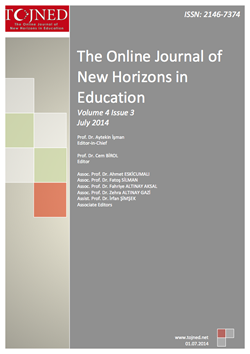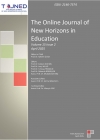TOJNED - Volume 2 - Issue 3 - July 2012
 A Qualitative Examination of University Engagement through the Lens of Business Executives
A Qualitative Examination of University Engagement through the Lens of Business Executives Chad Milewicz, Sudesh Mujumdar, Mohammed Khayum
Abstract: The Carnegie Commission on Higher Education and at least 311 Universities recognize the value of community engagement for universities. By definition, this engagement is intended to be mutually beneficial for all constituents. However, there is limited research with regard to the alignment of perspectives on the value of engagement across constituents. This paper finds that business executives do not perceive the university as receiving value from its engagement activities. Further research is called for to examine whether such a perception is a widespread phenomenon, as this has an important bearing on a university s strategic planning process
 ESTABLISHMENT FOR MISCONCEPTIONS THAT SCIENCE TEACHER CANDIDATES HAVE ABOUT GEOMETRIC OPTICS
ESTABLISHMENT FOR MISCONCEPTIONS THAT SCIENCE TEACHER CANDIDATES HAVE ABOUT GEOMETRIC OPTICS Suleyman AYDIN, P├ä┬▒nar URAL KELE├ģ┼Š, M. Akif HA├ģ┼ŠILO├ä┼ŠLU
Abstract: This study is planned to establish the misunderstandings that science teacher students have about optics. Study data was obtained from 35 sophomore students of Agri Education Faculty, Science Teaching Program during the time period of 2004-2005 fall semester, by applying a 3-tired multiple choice test, which contained 19 question articles and making interviews with ten different students. The result of the tests and interviews with students (teacher candidates) shows that students have misunderstandings about ├óŌé¼┼ōlight propagation├óŌé¼┬Ø, ├óŌé¼┼ōlight reflection,├óŌé¼┬Ø and ├óŌé¼┼ōlight refraction├óŌé¼┬Ø. Student s understanding levels on these subjects are 24.3%, 58% and 25% respectively. Some misunderstandings about light refraction are; ├óŌé¼┼ōSpecial beams have drawn as they are reflected from the thin and thick edged lenses├óŌé¼┬Ø and ├óŌé¼┼ōSpeed of light is constant and has the same value in all mediums├óŌé¼┬Ø. Some misunderstandings about reflection are; ├óŌé¼┼ōAbout the formation of an object s view at plane mirror, the changes of level and the place of source of the light that illuminates the object and changes of the level and place of observer change the view that appears in the mirror├óŌé¼┬Ø and ├óŌé¼┼ōSpecial beams do not reflect but refract and pass through the mirror├óŌé¼┬Ø. In addition, to know that teacher candidate students have a low level of understanding about light propagation, light reflection and light refraction. In order to establish these misconceptions and fix them in relative programs, representative classes are needed and this is important for science education.
 IMPACT OF TRAINING WORKSHOPS ON CREATION AND ADOPTION OF NEW ELECTRONIC SCIENTIFIC JOURNALS
IMPACT OF TRAINING WORKSHOPS ON CREATION AND ADOPTION OF NEW ELECTRONIC SCIENTIFIC JOURNALS Prof. Khalil Y. Al-Khalili
Abstract: A series of eleven workshops were organized by the Scientific Publishing Center (SPC) to faculty members each of which to a specific college associated with University of Bahrain (UoB). The total number of participants was 238. A structured questionnaire was distributed at the end of each workshop, and interviews with some of the participants were conducted. Data analysis indicated high levels of rating to these workshops on the seven aspects under concern. Workshop organization came at the top with a percentage of 94.4% of respondents giving it either very good or good. Topics covered was second with a rating of 93.5%. Time assigned to the workshop was third (92.6%).The fourth was method of presentation (92.0%), followed by used examples (91.7%). Profit gained from these workshops got a rating of (81.5%). Motivation for initiating electronic journals came at the end with a rating of (75.9%).The interviews showed a complete agreement on satisfaction of participants with such kind of workshops. Fifteen projects for initiating electronic journals were received from some of the participants.
 INVESTIGATION OF PRIMARY EDUCATION 6th, 7th and 8th GRADE STUDENTS ATTITUDES TOWARDS SCIENCE AND TECHNOLOGY LESSON
INVESTIGATION OF PRIMARY EDUCATION 6th, 7th and 8th GRADE STUDENTS ATTITUDES TOWARDS SCIENCE AND TECHNOLOGY LESSON ├ģ┼Širin YILMAZ, Bet├ā┬╝l T├ä┬░MUR
Abstract: This article aims to examine the attitudes of 6th, 7th, and 8th graders, who attend a good conditioned school in Serdivan, Sakarya, towards Science and Technology lesson. It was also examined whether there was a significant difference between attitude scores and girls and boys. In order to find out how to promote students attitudes towards science, 9 students were interviewed. The acquired quantitative data was analyzed in SPSS 13.0. The study findings indicated that there was a significant difference between the attitude to Science and Technology lesson and grades, whereas there was not any significant difference between the attitude scores and gender. Moreover, the qualitative data acquired through the interview with students indicated that the attitude towards science can be promoted carrying out more experiments and applying student-centered education.
 THE EVALUATION OF THE TEACHERS OPINIONS FOR LESSON PLANNING SAMPLES PREPARED BY USING CREATIVE DRAMA METHOD IN MATHEMATICS TEACHING
THE EVALUATION OF THE TEACHERS OPINIONS FOR LESSON PLANNING SAMPLES PREPARED BY USING CREATIVE DRAMA METHOD IN MATHEMATICS TEACHING Nesrin ├āŌĆōZSOY, Fatma ECZACININ, Zeynep Fidan KO├āŌĆĪAK[, Figen ├āŌĆōZPINAR
Abstract: This research is made for indicating the overview of the teachers about the mathematics lesson plan application in mathematics teaching, which is prepared by using creative drama method by class and math teachers who are the officers in primary school education between terms 20102011. The working group of the research is consisted of 40 teachers in Afyon and in Ä°zmir, who are the officers in 20 official primary schools and whom are selected randomly and as a volunteer. This research s data were collected by semi-structured interviews. The results obtained from analysis of the data are as follows: 45% of the teachers told that the planning is good. The lesson plan which is prepared by using creative drama method, is one of the ways that the teachers liked (35%) about attracting the students attention. 25% of teachers have acclaimed of the applicableness of the lesson plan, 22.5% have acclaimed of detailed content, 20% acclaimed of the activities in lesson plan, that make students be active and the use of drama method. The ability of making the teached topic understand of the plan making the knowledge permanent, removing the monotonousness of the lesson, smooth and funny situation of the lesson are the actions that are liked by the teachers. The vast majority of the teachers told that the crowded classroom and inadequate time are the difficulties in creative drama in the lesson plan of the size of the application which is prepared by using creative drama method in teaching of math. As 42,5% of the teachers indicated that there is not a place to make changes in the plan and stated that it is applicable, 17,5% of them advised that the event in the plan must be less in terms of time and proposed to give examples from our country.


